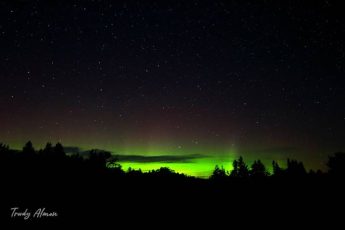This Week’s Sky at a Glance, 2024 March 16 – March 23
This Week’s Sky at a Glance, 2024 March 16 – March 23
With Sunday being party time for many O’Revelers, is there anything green that we can see in the sky? Yes, but rarely. We can see stars that are red, orange, yellow, blue or white, but not green. The colours are representative of their outer temperature, with red being coolest and blue the hottest. Any star with an outer temperature corresponding to green, which is in the middle wavelengths of the visible spectrum, emits approximately equal but lesser amounts of red and blue light. This combination gives us white light. Our Sun’s outer temperature of 5500 C puts it just on the green side of yellow.
Some stargazers have claimed to see green stars that are part of a binary pair with a red giant star. Green is the complementary colour of red, and it is thought that if you observe a white star after staring at a red one, the complementary after-image can make the white star look green. It is said that Zubeneschamali, the brightest star in Libra and the one with the longest single common name, is green. I did see it once as a very pale green in an 8-inch telescope, but that might have been due to the power of suggestion. Uranus usually looks pale green in a backyard telescope.
The most common reason for green in the sky, although still fairly rare in New Brunswick, is the northern lights. Energetic electrons from the Sun (aka Sol, the shortest name for a star) can make oxygen atoms in our upper atmosphere emit green light in a manner similar to that of a neon light. Northern lights are seen more frequently around the equinoxes, and if electrons in the solar wind have escaped the Sun through flares or holes in its magnetic field lines, we could get lucky this week. If not, then take a break from the partying to look up at the constellation O’Ryan.
This Week in the Solar System
Saturday’s sunrise in Moncton is at 7:28 and sunset will occur at 7:27, giving 11 hours, 59 minutes of daylight (7:33 and 7:32 in Saint John). Next Saturday the Sun will rise at 7:15 and set at 7:36, giving 12 hours, 21 minutes of daylight (7:20 and 7:41 in Saint John). The Sun crosses the equator at 6 minutes past midnight Wednesday morning, and spring will have sprung. Sunday is the day closest to having equal daylight, having 85 seconds more than 12 hours.
The Moon is at first quarter on Sunday and riding about as high as it can be in our sky. For the next two weeks Mercury will be at its evening best for the year and setting after 9 pm. Jupiter sets at 11:30 midweek, and on Thursday a telescope might reveal Jupiter’ Red Spot between 9 and 10 pm. Mars is rising around 6:30 this week. Venus and Saturn cross paths Friday morning but they are lost in bright morning twilight.
On Sunday evening at 8 pm, tune in to the Sunday Night Astronomy Show via the Facebook page or YouTube channel of Astronomy by the Bay.

